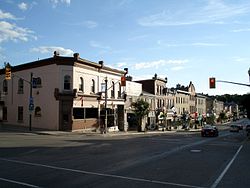St. Marys, Ontario
| St. Marys | |
|---|---|
| Town (single-tier) | |
| Town of St. Marys | |
 |
|
| Nickname(s): The StoneTown | |
| Motto: The Town Worth Living In | |
| Coordinates: 43°15.5′N 81°08′W / 43.2583°N 81.133°WCoordinates: 43°15.5′N 81°08′W / 43.2583°N 81.133°W | |
| Country |
|
| Province |
|
| Established | 1844 |
| Incorporated | 1864 |
| Government | |
| • Mayor | Al Strathdee |
| Area | |
| • Land | 12.48 km2 (4.82 sq mi) |
| Population (2011) | |
| • Total | 6,655 |
| • Density | 533.3/km2 (1,381/sq mi) |
| Time zone | EST (UTC-5) |
| • Summer (DST) | EDT (UTC-4) |
| Postal Code | N4X |
| Area code(s) | 519 and 226 |
| Website | townofstmarys.com |
St. Marys is a town in southwestern Ontario, Canada. It is located at the junction of Thames River and Trout Creek, southwest of Stratford and surrounded by the Township of Perth South. It is in the Perth census division but is independent of Perth County. The town is also known by its nickname, "The Stone Town", due to the abundance of limestone in the surrounding area, giving rise to a large number of limestone buildings and homes throughout the town. St. Marys Cement, a large cement producer founded in the town, capitalized on this close feedstock, and grew to be a major producer of cement in the province of Ontario.
St. Marys is home to the Canadian Baseball Hall of Fame. It is the burial place of Arthur Meighen, Canada's 9th Prime Minister. Timothy Eaton, who went on to become one of Canada's greatest retailers, opened his first businesses in Canada in St. Marys and nearby Kirkton, Ontario.
In 1839 the Canada Company sent a surveyor to Blanshard Township in the Huron Tract to choose a site for a town on the Thames River which would later be named St. Marys.
The first settlers arrived in St. Marys in the early 1840s, attracted by the area's natural resources. At the new town site, the Thames River cascaded over a series of limestone ledges, providing the power to run the first pioneer mills and giving the community an early nickname: Little Falls.
St. Marys was incorporated into the province of Ontario, officially, in 1863. However, it did not incorporate itself into Perth County.
In the riverbed and along the banks, limestone was close to the surface and could be quarried for building materials. Many 19th century limestone structures survive: churches, commercial blocks, and private homes. They have given St. Marys its current nickname: Stonetown.
...
Wikipedia

